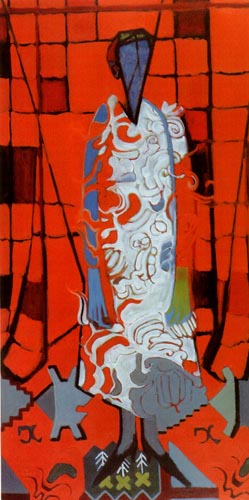Grande figure debout
(Tall standing figure)

1944-1947, oil painting on canvas, 200 x 100 cm
Coll. Musée L, Louvain-la-Neuve (Serge Goyens de Heusch donation)
N ° inv. 196
While Gaston Bertrand was not really enthusiast about the work of Matisse, he did not hesitate, however, to introduce a decorative dimension into his own works. This decorative dimension clearly appears in Grande figure debout, which he started to paint in 1944 and signed three years later. Indeed, Bertrand made several changes to the painting but the more spectacular one is the erasing of the figure’s facial features which were converted into a blue triangle. This is a surprising work which is the first major painting of the “iconic figures” series. Through the dialogue between the dominant red tone on one side and the blue shapes and white arabesques on the other side, as well as through the merging of the anonymous figure (though inspired by the large portrait of his mother painted in 1940) into the background texture, the painter aims at achieving a powerful decorative scheme and, as he himself admitted, seeks to evoke the desolation of mental and material decay due to the war. Gaston Bertrand considered this painting as a fundamental work in his artistic evolution and he explained: “this is the summary of the climate of suffering, destitution and negation prevailing in a poor neighbourhood of Brussels under the German occupation”.
Although art critics tended to relate this painting to expressionism, cubism or even surrealism, Bertrand was never a follower of any of these modern aesthetic movements: as a solitary artist, he had no difficulty in subduing the techniques that he learned in order to serve the authenticity of his own vision. Such an inner determination and independent mind gave rise to a very personal formal innovation which impressed his entourage and influenced the work of many of his colleagues from the Young Belgian Painting.